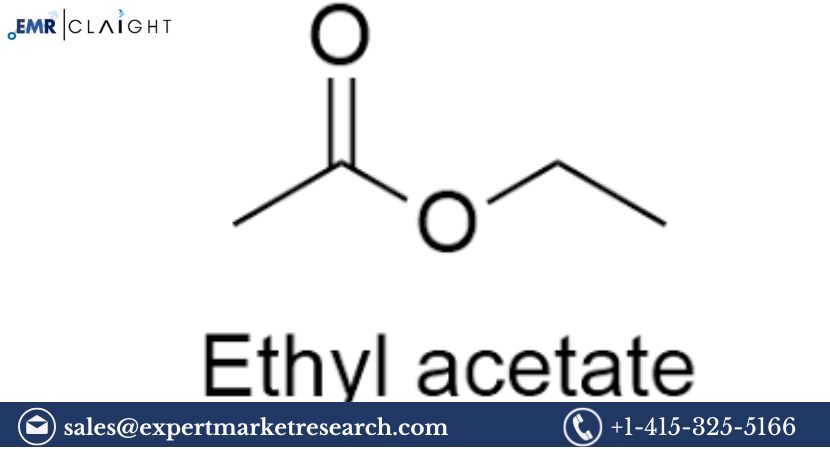Ethyl Acetate Market Size, Trends & Forecast 2025–2034
Ethyl acetate, a colorless liquid with a characteristic sweet smell, is commonly used as a solvent in paints, coatings, adhesives, and pharmaceuticals.

The ethyl acetate market is experiencing consistent demand owing to its wide-ranging applications in various industries. Its biodegradable nature and relatively low toxicity make it a preferred solvent in environmentally-conscious manufacturing processes. Increasing urbanization, rapid industrial development, and the expansion of sectors like packaging, pharmaceuticals, and personal care have accelerated the market demand. Additionally, its role as a flavor enhancer in the food and beverage industry further contributes to its rising consumption across the globe.
Ethyl Acetate Market Size
The ethyl acetate market reached a volume of approximately 4.53 million metric tons (MMT) in 2024, driven by increasing demand from diverse end-use industries such as paints and coatings, adhesives, pharmaceuticals, packaging, and printing. Ethyl acetate’s widespread usage as a solvent makes it an essential compound in several manufacturing processes. Among these, the paints and coatings sector remains the largest consumer due to the compound’s excellent solvency and quick evaporation properties. The Asia Pacific region dominates the market in terms of production and consumption, especially China and India, where rapid industrialization and urban development fuel demand. Europe and North America follow as mature markets with steady consumption. With rising investments in infrastructure, automotive, and construction industries, the need for industrial solvents like ethyl acetate continues to rise. Additionally, its role in eco-friendly manufacturing processes contributes to growing adoption across environmentally conscious regions. This strong base across multiple sectors has established ethyl acetate as a critical industrial input, thus maintaining its large market volume and setting the foundation for future growth. In the coming years, capacity expansions and technological innovations in bio-based production methods are also expected to contribute significantly to the overall market size.
Market Trends in the Ethyl Acetate Industry
Several key trends are currently shaping the ethyl acetate market landscape, leading to evolving production processes and usage patterns. One major trend is the increasing shift toward bio-based and green ethyl acetate, driven by global sustainability goals and tightening environmental regulations. Companies are investing in renewable feedstock technologies that utilize biomass instead of fossil fuels, resulting in lower carbon footprints and environmentally friendly solvents. Another significant trend is the rising demand for low-VOC (volatile organic compound) solvents, especially in the paints, coatings, and adhesives industries. As regulations become more stringent—particularly in Europe and North America—manufacturers are actively seeking alternatives like ethyl acetate that provide effective solvency with reduced environmental impact. Additionally, the growing use of ethyl acetate in pharmaceuticals as an extraction solvent and in drug formulation is gaining momentum post-COVID-19, especially with the increasing production of generic medicines and APIs. The packaging industry’s growth is another trend contributing to market expansion, particularly in flexible and food-grade packaging. Finally, manufacturers are leveraging advanced distillation and purification technologies to improve product quality and purity, catering to the rising demand from high-end applications such as electronics and precision coatings.
Market Opportunities and Challenges
There are multiple growth opportunities in the ethyl acetate market, primarily driven by rising industrialization in Asia Pacific and the increasing demand from the pharmaceutical and food industries. The move towards eco-friendly solvents presents further potential for innovation in bio-based ethyl acetate production. However, the market also faces several challenges, including fluctuating raw material prices, especially acetic acid and ethanol, which directly impact production costs. Additionally, stringent environmental regulations in some regions and the availability of substitute solvents can hinder market expansion if not addressed proactively by manufacturers.
Market Segmentation
Breakup by Application
- Paints and Coating
- Adhesives
- Inks
- Pharmaceutical
- Others
Breakup by Region
- North America
- Europe
- Asia Pacific
- Latin America
- Middle East and Africa
Ethyl Acetate Market Growth
The ethyl acetate market is experiencing steady growth due to its indispensable role as a solvent across a wide range of industries. In recent years, the compound has gained significant traction in sectors like paints and coatings, adhesives, pharmaceuticals, and packaging, where it is prized for its high solvency power and fast evaporation. The global growth trajectory is largely supported by industrial expansion in developing economies such as China, India, Brazil, and Southeast Asian nations. These countries are witnessing a surge in infrastructure development and automotive manufacturing, both of which demand large volumes of paints and adhesives. Moreover, as the pharmaceutical industry continues to expand—fueled by an aging population and increasing healthcare investments—ethyl acetate is finding greater use in drug formulation and extraction. Regulatory support for low-emission solvents and increased consumer demand for sustainable products further drive growth. Additionally, technological advancements in green chemistry and more efficient production processes are making ethyl acetate more cost-competitive and accessible. This widespread adoption and ongoing innovation contribute to the market’s robust annual growth rate, ensuring continued demand and expansion through 2034 and beyond.
Ethyl Acetate Market Forecast (2025–2034)
Looking ahead, the ethyl acetate market is projected to grow from 4.53 MMT in 2024 to 6.45 MMT by 2034, marking a CAGR of 3.60% during the forecast period of 2025 to 2034. This sustained growth reflects the compound’s rising demand across its core application areas, especially in Asia Pacific, where industrial activity remains strong. Countries such as China and India will likely continue leading the global market due to expanding manufacturing sectors and rising domestic consumption. In addition, North America and Europe are expected to see steady growth driven by the adoption of eco-friendly solvents and the increasing preference for green chemicals in industrial formulations. The forecast also factors in increased production capacities and strategic partnerships among key market players to meet growing demand. Furthermore, innovation in bio-based ethyl acetate production is expected to become a significant growth enabler, especially as sustainability becomes central to purchasing and manufacturing decisions. With industries such as automotive, construction, packaging, and pharmaceuticals continuously evolving and expanding, the demand for versatile solvents like ethyl acetate will remain high. This optimistic outlook positions the market for stable and long-term growth throughout the next decade.
Ethyl Acetate Market Competitor Analysis
The ethyl acetate market is moderately consolidated, with several global and regional players competing on pricing, innovation, and production capacity. Companies are focusing on strategic collaborations and eco-friendly production to gain competitive advantages.
Key Players:
Jiangmen Handsome Chemical Development Ltd. – Specializes in high-purity ethyl acetate for coatings and adhesives.
Jiangsu Sopo (Group) Co., Ltd. – Major player with vertical integration and wide regional presence in Asia.
Eastman Chemical Company – Offers bio-based ethyl acetate with a strong global supply chain.
Sekab – Focused on sustainable chemical production using renewable raw materials.
Shandong Jinyimeng Group Co. Ltd. – Leading supplier in China with diverse industrial chemical offerings.
Godavari Biorefineries Ltd. – Prominent Indian manufacturer with a focus on green chemistry.
INEOS Group – Global chemical giant known for large-scale production capabilities.
Solvay – Offers specialty ethyl acetate solutions with a global presence and innovation focus.
Others – Includes regional and niche players contributing to local supply and innovation.




